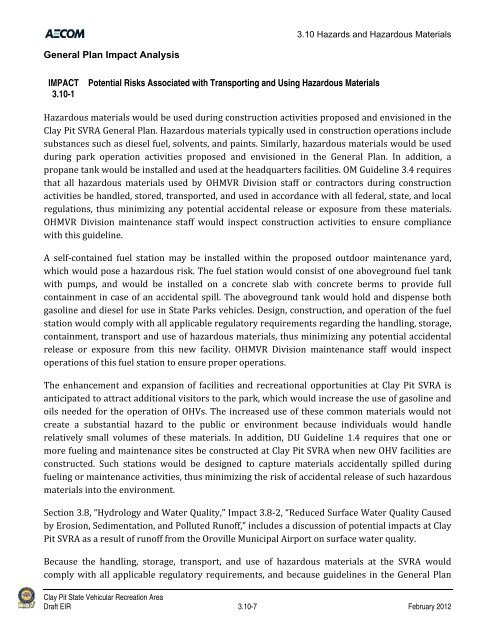Draft Environmental Impact Report - California Off Highway Vehicle ...
Draft Environmental Impact Report - California Off Highway Vehicle ...
Draft Environmental Impact Report - California Off Highway Vehicle ...
You also want an ePaper? Increase the reach of your titles
YUMPU automatically turns print PDFs into web optimized ePapers that Google loves.
General Plan <strong>Impact</strong> Analysis<br />
IMPACT<br />
3.10-1<br />
3.10 Hazards and Hazardous Materials<br />
Potential Risks Associated with Transporting and Using Hazardous Materials<br />
Hazardous materials would be used during construction activities proposed and envisioned in the<br />
Clay Pit SVRA General Plan. Hazardous materials typically used in construction operations include<br />
substances such as diesel fuel, solvents, and paints. Similarly, hazardous materials would be used<br />
during park operation activities proposed and envisioned in the General Plan. In addition, a<br />
propane tank would be installed and used at the headquarters facilities. OM Guideline 3.4 requires<br />
that all hazardous materials used by OHMVR Division staff or contractors during construction<br />
activities be handled, stored, transported, and used in accordance with all federal, state, and local<br />
regulations, thus minimizing any potential accidental release or exposure from these materials.<br />
OHMVR Division maintenance staff would inspect construction activities to ensure compliance<br />
with this guideline.<br />
A self‐contained fuel station may be installed within the proposed outdoor maintenance yard,<br />
which would pose a hazardous risk. The fuel station would consist of one aboveground fuel tank<br />
with pumps, and would be installed on a concrete slab with concrete berms to provide full<br />
containment in case of an accidental spill. The aboveground tank would hold and dispense both<br />
gasoline and diesel for use in State Parks vehicles. Design, construction, and operation of the fuel<br />
station would comply with all applicable regulatory requirements regarding the handling, storage,<br />
containment, transport and use of hazardous materials, thus minimizing any potential accidental<br />
release or exposure from this new facility. OHMVR Division maintenance staff would inspect<br />
operations of this fuel station to ensure proper operations.<br />
The enhancement and expansion of facilities and recreational opportunities at Clay Pit SVRA is<br />
anticipated to attract additional visitors to the park, which would increase the use of gasoline and<br />
oils needed for the operation of OHVs. The increased use of these common materials would not<br />
create a substantial hazard to the public or environment because individuals would handle<br />
relatively small volumes of these materials. In addition, DU Guideline 1.4 requires that one or<br />
more fueling and maintenance sites be constructed at Clay Pit SVRA when new OHV facilities are<br />
constructed. Such stations would be designed to capture materials accidentally spilled during<br />
fueling or maintenance activities, thus minimizing the risk of accidental release of such hazardous<br />
materials into the environment.<br />
Section 3.8, “Hydrology and Water Quality,” <strong>Impact</strong> 3.8‐2, “Reduced Surface Water Quality Caused<br />
by Erosion, Sedimentation, and Polluted Runoff,” includes a discussion of potential impacts at Clay<br />
Pit SVRA as a result of runoff from the Oroville Municipal Airport on surface water quality.<br />
Because the handling, storage, transport, and use of hazardous materials at the SVRA would<br />
comply with all applicable regulatory requirements, and because guidelines in the General Plan<br />
Clay Pit State Vehicular Recreation Area<br />
<strong>Draft</strong> EIR 3.10-7 February 2012








